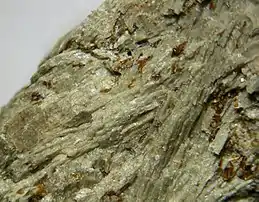| Aliettite | |
|---|---|
 Aliettite | |
| General | |
| Category | Phyllosilicates |
| IMA symbol | Ali[1] |
| Strunz classification | 9.EC.60 |
| Crystal system | Hexagonal Unknown space group |
| Unit cell | a = 5.216, c = 24.6 [Å]; Z = 1 |
| Identification | |
| Color | Colorless, pale yellow or green. |
| Crystal habit | Platy |
| Mohs scale hardness | 1–2 |
| Luster | Earthy (dull) |
| Streak | White |
| Diaphaneity | Translucent |
| Refractive index | 1.558–1.567 |
| References | [2][3][4][5] |
Aliettite is a complex phyllosilicate mineral of the smectite group with a formula of (Ca0.2Mg6(Si,Al)8O20(OH)4·4H2O)[2] or [Mg3Si4O10(OH)2](Ca0.5,Na)0.33(Al,Mg,Fe2+)2−3(Si,Al)4O10(OH)2·n(H2O).[3][4]
It is a soft, colorless to pale yellow or green earthy mineral which crystallizes in the monoclinic system as minute tabular to platy crystals.[2]
It was first described in 1968 for an occurrence in Monte Chiaro, Albareto, Parma Province, Emilia-Romagna, Italy and named for the Italian mineralogist Andrea Alietti (born 1923).[2]
It occurs in serpentinized ophiolites and their residual soil. It also occurs in altered dolomite. Associated minerals include talc, chlorite, serpentine and calcite.[4] In addition to the type locality in Italy it has been reported from Kinshasa, Katanga;[4] the Chelyabinsk Oblast of the southern Urals and the Turii alkaline Massif of the Kola Peninsula in Russia; the Zirabulak Mountains of Uzbekistan; and the Goldstrike Mine of Eureka County, Nevada, US.[2]
References